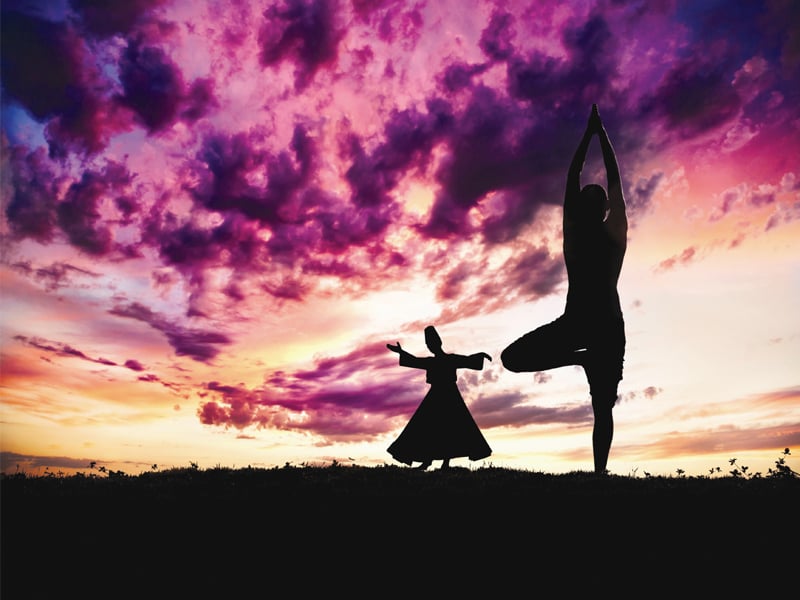
“This being human is a guest house. Every morning is a new arrival. A joy, a depression, a meanness, some momentary awareness comes as an unexpected visitor ... Welcome and entertain them all. Treat each guest honorably. The dark thought, the shame, the malice, meet them at the door laughing, and invite them in. Be grateful for whoever comes, because each has been sent as a guide from beyond.”
Kathryn teaches more than Asanas — the physical exercise to optimise posture, endurance and strength. Like a good Sufi, she also encourages her students to open their heart to possibilities.
But before you make a mad dash to find a Sufi-Yogi hybrid, remember, she is still largely an exception! Most yoga instructors are extremely mechanical in their approach and act more like drill sergeants than mystical gurus.
With 18 million yogis spending nearly $6 billion annually, the business of meditation has undoubtedly reached an epochal moment in its deep engagement with mainstream America. Sufism, too, appears to be crossing the chasm to a more spacious public understanding of a once marginal group.
In the island of Manhattan, where I live, I can find more yoga studios than health clubs, and more people carrying yoga mats than any other sporting gear. The number of Sufi institutions has also grown — not nearly with the same pace, but nevertheless noticeably. Why is it, you may wonder, that the capital of materialism has taken to yoga? Physical and emotional health is, in my opinion, the main driver but there are a handful of yogis in New York seeking enlightenment as well.
Starting from when Parmahansa Yogananda came to America back in 1920, yoga has taken off in the United States for a variety of reasons. In 1935, the Los Angeles Times reported on one of his lectures, saying: “The Philharmonic Auditorium presents the extraordinary spectacle of thousands … being turned away an hour before the advertised opening of a lecture with the 3,000-seat hall filled to its utmost capacity. Yogananda emphasised the underlying unity of the world’s great religions, and taught universally applicable methods for attaining direct personal experience of God.” Since those early days, eastern mysticism has made a home for itself in the US.
Another spiritual teacher, Swami Rama, a family friend with whom I had an audience more than two decades ago, was also able to establish himself quickly in the US. Sent by his teacher who had taken him into the Himalayan Tradition of cave yogis at the age of three, Swami Rama came to the West with traditional teachings from the cave monasteries and Patanjali’s sutras. When his teacher, Bengali Baba, sent him on his mission to the West, Sri Swami Rama asked him what he was to teach Americans. “Teach them not to be afraid,” he was instructed. Swami Rama worked with the Menninger Foundation in Topeka, Kansas. The Menninger experiments were deemed significant in the scientific community because it provided powerful support to biofeedback research. Swami Rama was able to demonstrate that body functions that had formerly been considered involuntary could be controlled through training the mind.
According to the National Centre for Complementary and Alternative Medicines, Americans practice yoga “for a variety of health conditions including anxiety disorders or stress, asthma, high blood pressure and depression. People also use Yoga as part of a general health regimen—to achieve physical fitness and to relax.” And it is very consistent with my informal research of yogis — and I call it informal because my primary methodology was chatting with fellow yogis in and outside of the studios. I have heard everything: yoga improves mood and sense of well-being, reduces stress, heart rate and blood pressure, increases lung capacity, improves muscle relaxation and body composition, and positively affects levels of certain brain chemicals. Very few have said they are looking for nirvana.
Compare that to Sufism — pretty much everyone claims to be searching for the higher truth — to elevate consciousness — reparation of the heart from all else but God. My fellow Sufis in New York want to travel into the presence of the Divine and purify their inner self. But of course, there are exceptions to this rule as well.
Abdul Rahim, the secretary of the Nur Ashiki Jerrahi Sufi Order, tells me that people want to get to the “core” and build a direct relationship with God. He thinks that the increasing popularity of Sufism is also due to a rejection of “dogmatic” religion. Sheikha Fariha al Jerrah, who leads this community of dervishes, delivers a weekly lecture after Maghrib prayers every Thursday in downtown New York at the Dergah al Farah, in which people from all religious and even non-religious backgrounds participate. Some observe the ‘Zikr’, while others simply observe — and my own personal observation is that the crowd just keeps getting larger. This order has circles throughout the US and Mexico and allows entry to “seekers and students of all religious and non-religious paths.”
I ran into two Pakistani men at a Thursday Zikr session, both of whom confirmed that it’s the ‘progressive’ nature of worship that attracts them to this Sufi order. A young woman was called on to recite the Azaan before Maghrib and men and women stood side-by-side to offer prayers. I asked these Pakistani men if they would go to a mosque in their hometown of Karachi if the call for prayer was led by a woman and the response was inconclusive and hedged at best. It’s particularly telling that they didn’t want to be identified in this article because they didn’t want to be ostracised by their families and friends.
Both of these Pakistani men had come because Thursday Zikr at this downtown dargah is open to the public and anyone can join this interesting and rather musical session. This open and inclusive approach is just another reason Sufism seems to be gaining currency in the US.
Many Americans are now familiar with the great Sufi mystic writer Rumi. His words of wisdom are found not only on Facebook pages and on Twitter but also in the cubicles of offices in corporate America. Elliot Miller, who writes for the Christian Research Institute, states: “The current interest in Sufism can be largely explained by pointing to the same factors which account for the popularity of several diverse Eastern mystical traditions among Westerners. These factors include a hunger for life transforming spiritual experiences, and an attraction to monistic belief systems.”
British Orientalist Martin Lings comments: “A Vendantist, a Taoist or a Buddhist can find in many aspects of Islamic mysticism, a ‘home from home’, such as he could less easily find in Christianity or Judaism.”
Oprah Winfrey recently did Sufism a favour by including it in Super Soul Sunday on her OWN Network. Sufi mystic Llewellyn Vaughan-Lee defined Sufism and explained why it’s about love and the heart. The fact that he was sitting under the oaks at Oprah’s home in California, was the best endorsement Sufism has had thus far.
I recently had a very interesting and candid conversation with Adnan Sarhan, the 80-year-old head of the Sufi Foundation in America. Hailing from Baghdad, he now teaches in New York, London, Paris and San Francisco as well as in his 40-acre Albuquerque, New Mexico, facility. When asked what Sufism is about, he replies: “It is about breathing, movement and heart.”
When the University of New Mexico asked him to teach a course on Sufism, he agreed but requested to change the title from ‘Sufism’ to ‘Dance’. “People lined up to take this ‘dance’ class- and I showed them how to control their body by mastering breathing techniques.” Many of his students eventually took a spiritual path after this gentle introduction.
Adnan drops a Hadith here and there and a Quranic verse enter his conversation every once in a while but his discourse is not specific to Islam. Religion, he says, is a code of conduct. It’s a matter of intellect, while Sufism is the business of the heart.
But Adnan has found a more grounded and perceptible technique for those of us who demand empirical evidence — he primarily dwells in the physicality of the practice. Instead of teaching mysticism, he demonstrates to his students how to control breathing to optimise flexibility of muscles, enhance postures and unleash creative potential. Therefore, it is no surprise that many of his followers are artists and dancers hoping to find a secret key that will take them to the top of their artistic ventures.
“Taking action is critical,” says Adnan. “It is more fun to dance, play sports and engage in physical activities rather than being lazy and inactive. Dance comes from the heart and it brings spirituality and peace. Dance is the yearning of the soul for freedom.”
Many cynics and puritans frown upon people like Bikram Chaudhry or Adnan Sarhan for making mysticism a consumer product — a kind of ‘McYoga’ or ‘McSufism’ for lack of a better term. But I personally believe a consumerist approach also makes these experiences accessible to mere mortals such as myself. And once you have that access and you take a step on this particular journey, who’s to say where it will lead you?
Published in The Express Tribune, Sunday Magazine, May 20th, 2012.




1726222798-0/Tribune-Pic-(13)1726222798-0-165x106.webp)


















COMMENTS
Comments are moderated and generally will be posted if they are on-topic and not abusive.
For more information, please see our Comments FAQ